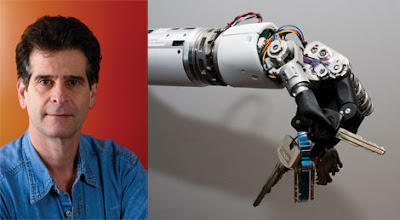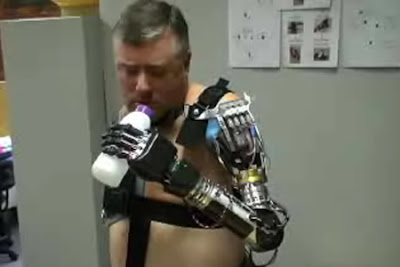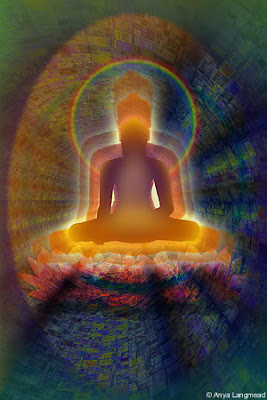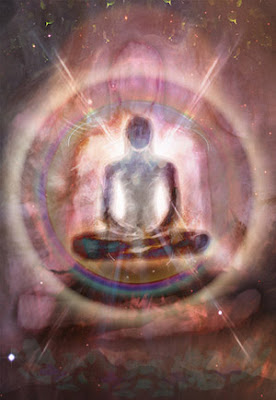Mar 10, 2008
IEEE Spectrum Online reports on prosthethic arm development
IEEE Spectrum Online has a special report on the current state of prosthethic arm development, including the latest on Dean Kamen's "Luke Arm" which is being funded by DARPA. There's also an amazing video showing the arm in action.
00:45 Posted in Neurotechnology & neuroinformatics | Permalink | Comments (0)
The art of Anya Langmead
00:41 Posted in Cyberart | Permalink | Comments (0) | Tags: cyberart
New platform for crowdsourcing
Via TheAppGap
Kluster is a platform for crowdsourcing and then organizing and putting to use skills, energy and availability on projects and initiatives. From the ReadWriteWeb review:
Kluster Launches at TED: A New Product in 72 Hours
Crowdsourcing firm Kluster officially launched yesterday at the TED conference, which is underway this week in Monterey, California. Founder Ben Kaufman, who bankrolled the company in part with money from the sale of his last company Mophie, has organized a gimmick over the course of the TED conference he hopes will prove Kluster’s worth. Kaufman intends to let TED attendees — and users from around the world — design a completely new product over the course of 72 hours.
The idea behind Kluster is that a group of passionate people working together can come up with better solutions for any decision-making problem than a single person. Whether that is planning an event, designing a new logo, or creating a new product, Kluster believes their system can.
[ Snip … ]
The Kluster system works by breaking down products into manageable chunks. For each chunk (or "phase"), people submit what are called "sparks." Sparks are proposed solutions for that phase. For each spark, other participants can submit "amps" — which are improvements to that idea. Users also assign "watts" to sparks and amps they like. Watts work kind of like investments. You accrue points based on participation and other factors, and can invest those points (watts) in ideas you like.Then an algorithm that takes into account "each user’s successes, failures, reputation, areas of expertise, and overall history" goes to work to determine which sparks are the best. Companies interested in using the Kluster system, put up cash prizes that are doled out along the way (at the completion of each phase).
00:15 Posted in Creativity and computers, Social Media | Permalink | Comments (0)
Mar 09, 2008
Cyber Goggles: High-tech memory aid
From Pink Tentacle
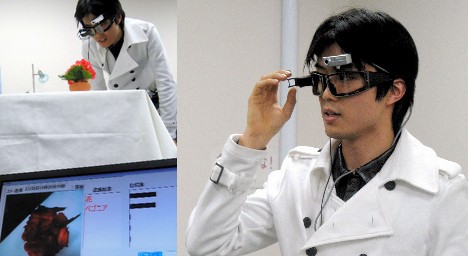
Researchers at the University of Tokyo have created a smart video goggle system that should records everything the wearer looks at, recognizes and assigns names to objects that appear in the video, and creates an easily searchable database of the recorded footage.
23:56 Posted in Future interfaces | Permalink | Comments (0) | Tags: future interfaces
Immersive Virtual, Mixed, or Augmented Reality Art

International Journal of Arts and Technology (IJART) - Call For Papers : Special Issue on Immersive Virtual, Mixed, or Augmented Reality Art : Guest Editors: Maria Roussou and Maurice Benayoun: Deadline: September 1, 2008.
For the past fifteen years, virtual reality (VR) and, more recently, mixed reality (MR) and augmented reality (AR) environments that immerse their participants in imaginary space, have emerged to define an area that blurs the lines between the seemingly different worlds of research, creativity, and technological practice, while exploring the interdependencies between the virtual and the physical. From the immersive, yet more esoteric, CAVE®-based projects of the mid-nineties to the contemporary open experiences spread out in virtual as well as physical space, creative VR / MR / AR applications are challenging the ways we perceive both digital art and the science and engineering behind them.
Early enthusiasm with the use of projection-based display structures and the development of authoring solutions for application-building has brought a level of maturity, characterized by the emergence of new technical and conceptual forms. It is this particular moment in the evolution of immersive VR / MR / AR art practice that this special issue seeks to capture. Hence, in this special issue, we aim to bring forth the topic of immersive art in its current maturity, present the newest developments and explore its evolving forms, aspiring to shape a framework that will help us to develop the next generation of environments.
Therefore, this special issue will not include contributions that deal solely with describing a narrow and specific piece of art or research without reference to a conceptual framework or a critical analysis; rather we encourage contributions that take a broad and integrative view of relevant topics, encompassing both theoretical and empirical perspectives of digitally-generated creative spaces.
Submissions are invited that touch on but are not limited to the following themes:
- Theoretical discourse on immersive virtual, mixed or augmented reality art environments.
- Novel design concepts, applications, implementations and experiences from the actual deployment of immersive VR / MR / AR art applications
- Research or empirical work addressing some of the open questions in the design of immersive art environments. For example:
- Issues concerning creativity and aesthetics, visual depiction, storytelling and narrative, triggering other senses, embodiment, etc.
- The fine line between designing for entertainment or for artistic pleasure
- Issues in the design of interactivity, interfaces, and interaction methodologies, such as navigation by and tracking of multiple users, meaningful group interaction, the integration of multi-modal interfaces (e.g. tactile and haptic displays, sensing technologies), etc.
- Issues concerning the design and development process of immersive artwork, such as the conceptualisation and collaboration challenges presented by multitalented interdisciplinary teams working together, the unavailability of resources and work environments, etc.
- Issues in the deployment of different display configurations, sizes, and installations, as well as challenges in the practical use with diverse audiences (e.g., the need to guide people in experiencing the artwork)
Contributions are encouraged from different disciplinary perspectives, including fine arts, computer science, performance art, theatre, design, architecture, communications and social sciences, philosophy, cognitive psychology, and enabling technologies.
Contributions should take a broad and integrative view of relevant topics, rather than merely describing a narrow and specific piece of art or research.
Important Dates
Submission intent (title and 300-word abstract): 1 September, 2008
Deadline for full paper submission: 31 October, 2008
Review results returned to authors: February 29, 2009
Deadline for camera-ready papers: June 30, 2009
23:42 Posted in Cyberart | Permalink | Comments (0) | Tags: cyberart
The efficacy of an augmented virtual reality system to alleviate pain in children undergoing burns dressing changes
The efficacy of an augmented virtual reality system to alleviate pain in children undergoing burns dressing changes: A randomised controlled trial.
Burns. 2008 Mar 4;
Authors: Mott J, Bucolo S, Cuttle L, Mill J, Hilder M, Miller K, Kimble RM
22:38 Posted in Cybertherapy | Permalink | Comments (0) | Tags: virtual reality
Mar 03, 2008
Google: Free Database Storage for Scientists
Via Medgadget
The storage will be free to scientists and access to the data will be free for all. The project, known as Palimpsest and first previewed to the scientific community at the Science Foo camp at the Googleplex last August, missed its original launch date this week, but will debut soon.
Building on the company's acquisition of the data visualization technology, Trendalyzer, from the oft-lauded, TED presenting Gapminder team, Google will also be offering algorithms for the examination and probing of the information. The new site will have YouTube-style annotating and commenting features.
The storage would fill a major need for scientists who want to openly share their data, and would allow citizen scientists access to an unprecedented amount of data to explore. For example, two planned datasets are all 120 terabytes of Hubble Space Telescope data and the images from the Archimedes Palimpsest, the 10th century manuscript that inspired the Google dataset storage project.
23:39 Posted in Research tools | Permalink | Comments (0) | Tags: research tools
Board Game: Fright Night At The ER
Re-blogged from Medgadget

Researchers at Breakthrough Learning have developed the world's most stressful board game to help foster systems thinking, collaboration, and innovation in the health care setting.
Played out over a simulated 24-hour day at a hospital, "Friday Night at the ER" graphically shows the downside of short-term thinking, faulty assumptions and an every-manager-for-himself philosophy.
Four-player teams try to juggle a limited number of hospital beds, a relentless influx of patients and a gradual attrition of nurses to care for them, all while racing against a clock that forced faster and faster decisions. Every so often, game cards announce another mini-crisis to ramp up the pressure.
The patient count in the ER waiting room soars as the day goes on, especially if the players running the operating room, critical care unit and medical-surgical floor don't cooperate to free up bed space, share nursing staff and think ahead to the next challenge.
"It's about collaboration and teamwork, about seeing your department as one piece of an enormous mosaic," game leader William Ward [Johns Hopkins University professor of health finance and management -ed] told the players. "Whether it's lab, registration, records, we tend to manage just in our own little departments. I swear at the bottom of the Atlantic there's still a hospital department manager in dry room on the Titanic who went down thinking 'It's OK. My department is dry.'"
23:25 Posted in Creativity and computers | Permalink | Comments (0) | Tags: creativity and computers
Brain-computer interfaces in the continuum of consciousness
Brain-computer interfaces in the continuum of consciousness.
Curr Opin Neurol. 2007 Dec;20(6):643-9
Authors: Kübler A, Kotchoubey B
PURPOSE OF REVIEW: To summarize recent developments and look at important future aspects of brain-computer interfaces. RECENT FINDINGS: Recent brain-computer interface studies are largely targeted at helping severely or even completely paralysed patients. The former are only able to communicate yes or no via a single muscle twitch, and the latter are totally nonresponsive. Such patients can control brain-computer interfaces and use them to select letters, words or items on a computer screen, for neuroprosthesis control or for surfing the Internet. This condition of motor paralysis, in which cognition and consciousness appear to be unaffected, is traditionally opposed to nonresponsiveness due to disorders of consciousness. Although these groups of patients may appear to be very alike, numerous transition states between them are demonstrated by recent studies. SUMMARY: All nonresponsive patients can be regarded on a continuum of consciousness which may vary even within short time periods. As overt behaviour is lacking, cognitive functions in such patients can only be investigated using neurophysiological methods. We suggest that brain-computer interfaces may provide a new tool to investigate cognition in disorders of consciousness, and propose a hierarchical procedure entailing passive stimulation, active instructions, volitional paradigms, and brain-computer interface operation.
23:24 Posted in Brain-computer interface | Permalink | Comments (0) | Tags: Brain-computer interface
Integrating a Portable Biofeedback Device into Clinical Practice for Patients with Anxiety Disorders
Integrating a Portable Biofeedback Device into Clinical Practice for Patients with Anxiety Disorders: Results of a Pilot Study.
Appl Psychophysiol Biofeedback. 2008 Feb 20;
Authors: Reiner R
This study examined the effectiveness of a portable Respiratory Sinus Arrhythmia (RSA) biofeedback device as an adjunct to CBT in persons with anxiety disorders and other disorders associated with autonomic dysfunction attending outpatient treatment. Participants were 24 individuals attending outpatient cognitive behavioral treatment for a range of anxiety disorders. Participants were assessed over a 3 week period. Outcomes included measures of anxiety (STAI-Y), sleep disturbances (PSQI), anger (STAEI), and subjective questions about the effectiveness of the device as a treatment adjunct. Significant reductions were found for anxiety and anger and for certain sleep variables (e.g. sleep latency). There was a significant dos-effect in that those who were more compliant had significantly greater reductions in most domains including sleep, anger and trait anxiety. Overall, participants found the device more helpful than other relaxation techniques such as mediation, yoga and unassisted breathing techniques but less helpful than exercise. The most frequently endorsed side effects were dizziness (15%) and sleepiness (55%). These preliminary results suggest that portable RSA biofeedback appears to be a promising treatment adjunct for disorders of autonomic arousal and is easily integrated into treatment. Results support the need for further investigation with more rigorous experimental designs.
23:21 Posted in Biofeedback & neurofeedback | Permalink | Comments (0) | Tags: biofeedback
Virtual reality and paranoid ideations in people with an 'at-risk mental state' for psychosis
Virtual reality and paranoid ideations in people with an 'at-risk mental state' for psychosis.
Br J Psychiatry Suppl. 2007 Dec;51:s63-8
Authors: Valmaggia LR, Freeman D, Green C, Garety P, Swapp D, Antley A, Prescott C, Fowler D, Kuipers E, Bebbington P, Slater M, Broome M, McGuire PK
BACKGROUND: Virtual reality provides a means of studying paranoid thinking in controlled laboratory conditions. However, this method has not been used with a clinical group. AIMS: To establish the feasibility and safety of using virtual reality methodology in people with an at-risk mental state and to investigate the applicability of a cognitive model of paranoia to this group. METHOD: Twenty-one participants with an at-risk mental state were assessed before and after entering a virtual reality environment depicting the inside of an underground train. RESULTS: Virtual reality did not raise levels of distress at the time of testing or cause adverse experiences over the subsequent week. Individuals attributed mental states to virtual reality characters including hostile intent. Persecutory ideation in virtual reality was predicted by higher levels of trait paranoia, anxiety, stress, immersion in virtual reality, perseveration and interpersonal sensitivity. CONCLUSIONS: Virtual reality is an acceptable experimental technique for use with individuals with at-risk mental states. Paranoia in virtual reality was understandable in terms of the cognitive model of persecutory delusions.
23:18 Posted in Virtual worlds | Permalink | Comments (0) | Tags: virtual reality
Processing of peripersonal and extrapersonal space using tools
Processing of peripersonal and extrapersonal space using tools: Evidence from visual line bisection in real and virtual environments.
Neuropsychologia. 2007 Dec 27;
Authors: Gamberini L, Seraglia B, Priftis K
The dissociation between peripersonal space (within reaching) and extrapersonal space (beyond reaching) has been reported in studies using the line bisection task in left neglect patients and in healthy participants. Furthermore, this dissociation can be modulated by tool use. We conducted two experiments to compare line bisection in peripersonal (i.e., 30, 60cm) and extrapersonal space (i.e., 90, 120cm). Healthy participants bisected visual lines using sticks and a laser pointer, according to the experimental paradigm of Longo and Lourenco [On the nature of near space: Effects of tool use and the transition to far space. Neuropsychologia, 44, 977-981, 2006]. In Experiment 1 participants performed line bisection in a real environment, whereas in Experiment 2 participants performed line bisection in a virtual environment. Results from both experiments revealed an abrupt midpoint shift from the peripersonal to the extrapersonal space but only when a laser pointer was used. In addition, we confirmed that peripersonal space can be extended to extrapersonal space when participants used a stick. Notably, virtual reality can be a useful technique for studying the dissociation between peripersonal and extrapersonal space and their interaction by means of tool use.
23:16 Posted in Virtual worlds | Permalink | Comments (0) | Tags: virtual reality
The nicotine craving experience in virtual reality
Location and longing: The nicotine craving experience in virtual reality.
Drug Alcohol Depend. 2008 Feb 1;
Authors: Carter BL, Bordnick P, Traylor A, Day SX, Paris M
Considerable research suggests that cigarette craving is complex, with psychological, emotional, cognitive, and behavioral aspects that are inadequately captured by typical craving assessments that focus on level of severity. That is, the experience of craving, for cigarette smokers, remains poorly understood. This study immersed smokers in different virtual reality (VR) scenarios (with and without cigarette cues present), collected detailed craving assessments, and analyzed the data using a multidimensional analytic approach. Non-treatment-seeking, nicotine dependent smokers (N=22) experienced two different virtual reality scenarios, one with cigarette cues and one without, and rated 24 descriptors related to craving. Multidimensional scaling (MDS) models demonstrate that smokers' experience of craving is qualitatively, structurally different under VR smoking cue conditions versus neutral conditions. This finding sheds new light on the complexity of craving as well as implications for its measurement.
23:15 Posted in Virtual worlds | Permalink | Comments (0) | Tags: virtual reality
Allocentric memory impaired and egocentric memory intact as assessed by virtual reality in recent-onset schizophrenia
Allocentric memory impaired and egocentric memory intact as assessed by virtual reality in recent-onset schizophrenia.
Schizophr Res. 2008 Feb 12;
Authors: Weniger G, Irle E
Present evidence suggests that schizophrenia is associated with explicit memory deficits, whereas implicit memory seems to be largely preserved. Virtual reality studies on declarative allocentric memory in schizophrenia are rare, and studies on implicit egocentric memory in schizophrenia are lacking. However, virtual realities have a major advantage for the assessment of spatial navigation and memory formation, as computer-simulated first-person environments can simulate navigation in a large-scale space. Twenty-five subjects with recent-onset schizophrenia were compared with 25 healthy matched control subjects on two virtual reality tasks affording the navigation and learning of a virtual park (allocentric memory) and a virtual maze (egocentric memory). Compared with control subjects, schizophrenia subjects were significantly impaired in learning the virtual park. However, schizophrenia subjects were as able as control subjects to learn the virtual maze. Stronger disorganized symptoms of schizophrenia subjects were significantly related to more errors on the virtual maze. It is concluded that egocentric spatial learning adds to the many other implicit cognitive skills being largely preserved in schizophrenia. Possibly, the more global neural network supporting egocentric spatial learning is less affected than the declarative hippocampal memory system in early stages of schizophrenia and may offer opportunities for compensation in the presence of focal deficits.
23:13 Posted in Research tools | Permalink | Comments (0) | Tags: virtual reality
Assessing reactivity to virtual reality alcohol based cues
Assessing reactivity to virtual reality alcohol based cues.
Addict Behav. 2008 Jan 2
Authors: Bordnick PS, Traylor A, Copp HL, Graap KM, Carter B, Ferrer M, Walton AP
The use of virtual reality (VR) programs in behavioral science research has been gaining prominence over the past several years. In the field of substance abuse, VR cue reactivity programs have been successfully tested for feasibility in nicotine and cocaine dependent samples. Seeking to expand VR applications in alcohol cue research, a novel VR alcohol cue reactivity assessment system incorporating visual, auditory, and olfactory stimuli was developed and tested. In a controlled trial, 40 non-treatment-seeking drinkers with alcohol use disorders were exposed to VR alcohol cue environments. Subjective craving, attention to alcohol cues, and level of presence (realism of experience) in VR were assessed across the environments. Overall, subjective craving for alcohol increased across the VR alcohol-related cue environments versus VR neutral cue environments. Participants reported high levels of presence in VR, indicating that the environments were perceived as realistic and compelling. These initial findings support the use of VR based cue reactivity environments for use in alcohol cue-based treatment and research.
23:11 Posted in Cybertherapy | Permalink | Comments (0) | Tags: virtual reality
Development of symbolic play through the use of virtual reality tools in children with autistic spectrum disorders
Development of symbolic play through the use of virtual reality tools in children with autistic spectrum disorders: Two case studies.
Autism. 2008 Mar;12(2):143-57
Authors: Herrera G, Alcantud F, Jordan R, Blanquer A, Labajo G, De Pablo C
Difficulties in understanding symbolism have been documented as characteristic of autistic spectrum disorders (ASDs). In general, virtual reality (VR) environments offer a set of potential advantages for educational intervention in ASD. In particular, VR offers the advantage, for teaching pretend play and for understanding imagination, of it being possible to show these imaginary transformations explicitly. This article reports two case studies of children with autism (aged 8:6 and 15:7, both male), examining the effectiveness of using a VR tool specifically designed to work on teaching understanding of pretend play. The results, confirmed by independent observers, showed a significant advance in pretend play abilities after the intervention period in both participants, and a high degree of generalization of the acquired teaching in one of them.
23:10 Posted in Cybertherapy | Permalink | Comments (0) | Tags: virtual reality
Feb 24, 2008
Research post in "cognitive and communication processes in media use"
A 12 month full-time contract for a research post will be available in the Department of Psychology at the Catholic University of the Sacred Heart in Milano, Italy . The contract will start in June 2008. The contract can be renewed for further 12-month periods.
Project
The post is connected to a project entitled "Cognitive and communication processes in media use” and is completely funded by the Catholic University of the Sacred Heart. The project is being led by Professor Alessandro Antonietti (www.antonietti.psycholab.net)
Requirements: PhD in Psychology or allied disciplines
Language skills: fluent English (written and speech).
A clear interest in the topic of the project and proven qualifications for doing research.
The research activities will be based in the Department and Faculty of Psychology at the Catholic University of the Sacred Heart in Milano (www.unicatt.it).
Salary
The salary is 1,345.00 euros per month. The salary is free from taxes. An insurance deduction (5.00%) might be applied (it depends on the nationality of the candidate).
Applications
The official announcement will be delivered at the end of March 2008. The application forms and further details will available in April 2008 from the website of the Catholic University of the Sacred Heart (http://www.unicatt.it/)
Candidates will apply by sending the following documents:
- the application forms - curriculum vitae including list of publications
- the research design (approximately 6 page written in English) that the candidate would carry out.
Alessandro Antonietti Professor of Cognitive Psychology
Head of the Department of Psychology
(Tel) +39-02-72342909 (Fax) +39-02-72342280
(E-mail) alessandro.antonietti@unicatt.it
(Postal address) Catholic University of the Sacred Heart, Largo Gemelli 1, 20123 Milano, Italy
21:33 Posted in Research institutions & funding opportunities | Permalink | Comments (0)
Feb 11, 2008
Electroencephalographic (EEG) Measurements of Mindfulness-based Triarchic Body-pathway Relaxation Technique
Electroencephalographic (EEG) Measurements of Mindfulness-based Triarchic Body-pathway Relaxation Technique: A Pilot Study.
Appl Psychophysiol Biofeedback. 2008 Jan 24;
Authors: Chan AS, Han YM, Cheung MC
OBJECTIVE: The "Triarchic body-pathway relaxation technique" (TBRT) is a form of ancient Chinese mindfulness-based meditation professed to give rise to positive emotions and a specific state of consciousness in which deep relaxation and internalized attention coexist. The purpose of this study was to examine the EEG pattern generated during the practice of this mindfulness exercise, and compare it to music listening which has been shown to induce positive emotions. METHODS: Nineteen college students (aged 19-22 years) participated in the study. Each participant listened to both the TBRT and music audiotapes while EEG was recorded. The order of presentation was counterbalanced to avoid order effect. Two EEG indicators were used: (1) alpha asymmetry index, an indicator for left-sided anterior activation, as measure of positive emotions, and (2) frontal midline theta activity, as a measure for internalized attention. RESULTS: Increased left-sided activation, a pattern associated with positive emotions, was found during both TBRT exercise and music conditions. However, only TBRT exercise was shown to exhibit greater frontal midline theta power, a pattern associated with internalized attention. CONCLUSIONS: These results provided evidence to support that the TBRT gives rise to positive emotional experience, accompanied by focused internalized attention.
22:38 Posted in Meditation & brain | Permalink | Comments (0) | Tags: meditation
Effect of mental imagery on the development of skilled motor actions
Effect of mental imagery on the development of skilled motor actions.
Percept Mot Skills. 2007 Dec;105(3 Pt 1):803-26
Authors: Fontani G, Migliorini S, Benocci R, Facchini A, Casini M, Corradeschi F
To test the effect of imagery in the training of skilled movements, an experiment was designed in which athletes learned a new motor action and trained themselves for a month either by overt action or by mental imagery of the action. The experiment was carried out with 30 male karateka (M age = 35 yr., SD = 8.7; M years of practice = 6, SD = 3) instructed to perform an action (Ura-Shuto-Uchi) that they had not previously learned. The athletes were divided into three groups: Untrained (10 subjects who did not perform any training), Action Trained (10 subjects who performed Ura-Shuto-Uchi training daily for 16 minutes), and Mental Imagery (10 subjects who performed mental imagery training of Ura-Shuto-Uchi daily for 16 minutes). The subjects were tested five times, once every 7 days. During each test, they performed a series of 60 motor action trials. In Tests 1, 3, and 5, they also performed a series of 60 mental imagery trials. During the trials, an electroencephalogram (EEG), electromyography (EMG), muscle strength and power, and other physiological parameters were recorded. The results differed by group. Untrained subjects did not show significant effects. In the Action Trained group, training had an effect on reactivity and movement speed, with a reduction of EMG activation and reaction times. Moreover, muscle strength, power, and work increased significantly. The Mental Imagery group showed the same effects on muscle strength, power, and work, but changes in reactivity were not observed. In the Mental Imagery group, the study of Movement Related Brain Macropotentials indicated a progressive modification of the profile of the waves from Test 1 to Test 5 during imagery, showing significant variations of the amplitude of the waves related to the premotor and motor execution periods. Results show that motor imagery can influence muscular abilities such as strength and power and can modify Movement Related Brain Macropotentials, the profile of which potentially could be used to verify the effectiveness of motor imagery training.
22:36 Posted in Mental practice & mental simulation | Permalink | Comments (0) | Tags: mental practice, mental simulation
Effect of mental imagery on the development of skilled motor actions
Effect of mental imagery on the development of skilled motor actions.
Percept Mot Skills. 2007 Dec;105(3 Pt 1):803-26
Authors: Fontani G, Migliorini S, Benocci R, Facchini A, Casini M, Corradeschi F
To test the effect of imagery in the training of skilled movements, an experiment was designed in which athletes learned a new motor action and trained themselves for a month either by overt action or by mental imagery of the action. The experiment was carried out with 30 male karateka (M age = 35 yr., SD = 8.7; M years of practice = 6, SD = 3) instructed to perform an action (Ura-Shuto-Uchi) that they had not previously learned. The athletes were divided into three groups: Untrained (10 subjects who did not perform any training), Action Trained (10 subjects who performed Ura-Shuto-Uchi training daily for 16 minutes), and Mental Imagery (10 subjects who performed mental imagery training of Ura-Shuto-Uchi daily for 16 minutes). The subjects were tested five times, once every 7 days. During each test, they performed a series of 60 motor action trials. In Tests 1, 3, and 5, they also performed a series of 60 mental imagery trials. During the trials, an electroencephalogram (EEG), electromyography (EMG), muscle strength and power, and other physiological parameters were recorded. The results differed by group. Untrained subjects did not show significant effects. In the Action Trained group, training had an effect on reactivity and movement speed, with a reduction of EMG activation and reaction times. Moreover, muscle strength, power, and work increased significantly. The Mental Imagery group showed the same effects on muscle strength, power, and work, but changes in reactivity were not observed. In the Mental Imagery group, the study of Movement Related Brain Macropotentials indicated a progressive modification of the profile of the waves from Test 1 to Test 5 during imagery, showing significant variations of the amplitude of the waves related to the premotor and motor execution periods. Results show that motor imagery can influence muscular abilities such as strength and power and can modify Movement Related Brain Macropotentials, the profile of which potentially could be used to verify the effectiveness of motor imagery training.
22:35 Posted in Mental practice & mental simulation | Permalink | Comments (0) | Tags: mental practice, mental simulation







